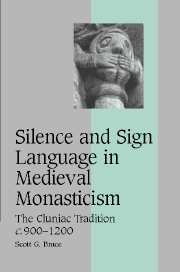Book contents
- Frontmatter
- Contents
- List of tables
- Acknowledgments
- List of abbreviations
- Map
- INTRODUCTION: THE DORMANT LANGUAGE
- 1 UTTERING NO HUMAN SOUND
- 2 THE TRAINING OF THE HAND
- 3 A SILENT COMMERCE OF SIGNS
- 4 TRANSMISSION AND ADAPTATION
- 5 CONTINUITY AND CRITICISM
- CONCLUSION
- Appendix A: The Cluniac sign lexicon
- Bibliography
- Index
- Cambridge Studies in Medieval Life and Thought Fourth Series
4 - TRANSMISSION AND ADAPTATION
Published online by Cambridge University Press: 16 July 2009
- Frontmatter
- Contents
- List of tables
- Acknowledgments
- List of abbreviations
- Map
- INTRODUCTION: THE DORMANT LANGUAGE
- 1 UTTERING NO HUMAN SOUND
- 2 THE TRAINING OF THE HAND
- 3 A SILENT COMMERCE OF SIGNS
- 4 TRANSMISSION AND ADAPTATION
- 5 CONTINUITY AND CRITICISM
- CONCLUSION
- Appendix A: The Cluniac sign lexicon
- Bibliography
- Index
- Cambridge Studies in Medieval Life and Thought Fourth Series
Summary
Despite the dangers of long-distance travel in an uncertain age, monks of ability and promise were continually on the move between the monasteries of northern Europe in the tenth and eleventh centuries. The Rule of Benedict generally frowned on itinerant monks, but its precepts made allowance for individuals to leave the abbey precincts for legitimate reasons with the abbot's permission. Some took to the roads in an official capacity as royal escorts, like the Anglo-Saxon monk-bishop Coenwald, who in 929 escorted two sisters of King Æthelstan to the court of Henry the Fowler in Germany. Coenwald took the opportunity on this journey to visit local abbeys, including St. Gall, where he entered the names of his kinfolk and king into the confraternity book. Others traveled more discreetly between monastic centers as teachers and students. In 985, Abbo of Fleury went to Ramsey abbey in England, where he stayed for two years to instruct monks in the customs of his community. Likewise, throughout the tenth century, promising Anglo-Saxon youths were sent to the abbey of Fleury in the Loire Valley to learn the monastic life. Among them were Oda, who became archbishop of Canterbury (941–958), and his nephew Oswald, later archbishop of York (972–992). Whatever their purpose or destination, these brethren bore with them an intimate knowledge of the customs of their own houses as well as a curiosity about the traditions of the foreign monks they encountered or among whom they lived for a short time.
- Type
- Chapter
- Information
- Silence and Sign Language in Medieval MonasticismThe Cluniac Tradition, c.900–1200, pp. 98 - 142Publisher: Cambridge University PressPrint publication year: 2007

